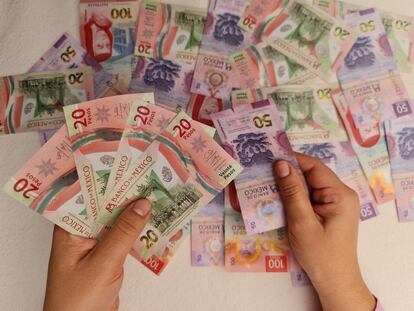Rising remittances, juicy interest rates and nearshoring: the reasons that are boosting the Mexican peso
The currency recently reached its best exchange rate against the US dollar since December 2015

Mexico’s peso is enjoying its best performance in the past eight years. The currency recently dropped below 16.98 to the US dollar, a level not seen since December 2015. The peso surged again in early July after data showed that positive remittances (money flowing from the US to Mexico) hit a new record in May: a staggering $5.693 billion. Several factors contributed to this unprecedented achievement: the Bank of Mexico’s decision to hold interest rates at 11.25%; stable public finances; and rosy forecasts of increased nearshoring exports and investments. “The [peso’s] movement left us speechless – it’s the absolute best scenario,” said Marcos Arias, an analyst at Grupo Financiero Monex.
Gabriela Siller, Banco Base’s director of analysis, says that the peso’s appreciation is due to greater demand for the currency as an investment asset, and not because of weakness in the US dollar. It’s also a reaction to the anticipated influx of dollars resulting from nearshoring – companies relocating to Mexico to be near US markets. If the latest US employment data (released on July 7) is favorable, which it was, Monex estimates the Mexican peso could reach 16.80 to the dollar.
Experts unanimously acknowledge the remarkable resilience of the Mexican peso against the dollar. It has withstood choppiness in capital markets for months, and year-to-date, it has experienced a noteworthy appreciation of over 12.3% compared to the dollar. The stars have aligned in favor of the Mexican currency, with record-breaking remittance data, growing exports, and the interest rate differential between Mexico (11.25%) and the United States (5-5.25%). Investors who placed bets on peso-denominated assets have seen healthy returns, which in turn stimulated nearshoring and the Mexican economy overall.
Exchange rates below 17 pesos to the dollar generally benefit importers and public debt management, and also help curb prices of imported goods. On the flip side, a strong peso inhibits export competitiveness and industries like tourism that bring in foreign currency, while also reducing the purchasing power of Mexicans who depend on regular remittances from abroad.
No ominous clouds loom on the horizon to mar the optimistic trend of the Mexican peso. Nevertheless, Arias notes persistent concerns of a potential economic downturn in the United States, which could cast a global shadow over the financial landscape. Upcoming elections in both Mexico and the United States may also lead to exchange rate volatility, compounding existing challenges.
According to Banco Base’s projections, if the currency maintains the trend observed since July 2022, it could reach 16.74 pesos per dollar in 2023. However, Monex is more cautious and estimates an exchange rate of 19.10 pesos per dollar by year-end, with a downward bias.
Sign up for our weekly newsletter to get more English-language news coverage from EL PAÍS USA Edition
Tu suscripción se está usando en otro dispositivo
¿Quieres añadir otro usuario a tu suscripción?
Si continúas leyendo en este dispositivo, no se podrá leer en el otro.
FlechaTu suscripción se está usando en otro dispositivo y solo puedes acceder a EL PAÍS desde un dispositivo a la vez.
Si quieres compartir tu cuenta, cambia tu suscripción a la modalidad Premium, así podrás añadir otro usuario. Cada uno accederá con su propia cuenta de email, lo que os permitirá personalizar vuestra experiencia en EL PAÍS.
¿Tienes una suscripción de empresa? Accede aquí para contratar más cuentas.
En el caso de no saber quién está usando tu cuenta, te recomendamos cambiar tu contraseña aquí.
Si decides continuar compartiendo tu cuenta, este mensaje se mostrará en tu dispositivo y en el de la otra persona que está usando tu cuenta de forma indefinida, afectando a tu experiencia de lectura. Puedes consultar aquí los términos y condiciones de la suscripción digital.
More information
Archived In
Últimas noticias
Welcome to the post-religion era: The idea of Christianity as the absolute truth has become obsolete
‘I thought you would like it’: The risky sexual practice popularized by TV shows and TikTok
The digitalization of tourism: ‘They promise experiences and gave us the worst possible one’
Mexican peso defies uncertainty with forecasts of a new period of stability in 2026
Most viewed
- Sinaloa Cartel war is taking its toll on Los Chapitos
- Oona Chaplin: ‘I told James Cameron that I was living in a treehouse and starting a permaculture project with a friend’
- Reinhard Genzel, Nobel laureate in physics: ‘One-minute videos will never give you the truth’
- Why the price of coffee has skyrocketed: from Brazilian plantations to specialty coffee houses
- Silver prices are going crazy: This is what’s fueling the rally











































